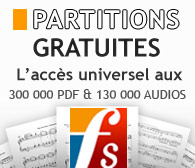| Debussy, Claude - "Arabesque" No. 2 for Concert Harp Harpe |
VoirPDF : "Arabesque" No. 2 for Concert Harp (10 pages - 315.22 Ko)1 457x⬇ MP3 (315.22 Ko)259x⬇ 1647x
| Compositeur : | Debussy, Claude (1862 - 1918) | ||||
| Instrumentation : | Harpe1 autre version | ||||
| Genre : | Romantique | ||||
| Arrangeur : Editeur : | MAGATAGAN, MICHAEL (1960 - ) | ||||
| Date : | 1888 | ||||
| Droit d'auteur : | Public Domain | ||||
| Ajoutée par magataganm, 26 Aoû 2012 The Two Arabesques (Deux arabesques), L. 66, is a pair of arabesques composed by Claude Debussy. They are two of Debussy's earliest works, composed between the years 1888 and 1891, when he was still in his twenties. Although quite an early work, the arabesques contain hints of Debussy's developing musical style. The suite is one of the very early impressionistic pieces of music, following the French visual art form. Debussy seems to wander through modes and keys, and achieves evocative scenes through music. The Arabesque No. 2 (Andantino con moto) is written in the key of G major and is noticeably quicker and more lively in tempo than the Arabesque No. 1. It opens with left hand chords and right hand trills. The pieces makes several transpositions and explores a lower register of the piano. Again notable is a hint of the pentatonic scale. The style more closely resembles some of Debussy's later works. Like the closing bars of the first arabesque, this arabesque closes in a similar fashion. The vocabulary of Debussy's music is rich in harmonic dimension. The composer uses 7ths, 9ths, 11th and more, while he intersperses whole tone progressions that are so characteristic of his writing. If density, or volume ever applied to musical performance, this piece meets all requirements for a slow entry into notes, and a swimming motion through them therefore although originally written for Piano (and variations thereof), I chose to create this arrangement for concert harp to accentuate these characteristics of the original work. Partition centrale : | Deux Arabesques (25 partitions) | | |||
© 2000 - 2024
Accueil - Nouveautés - Compositeurs
Mentions légales - Version intégrale








